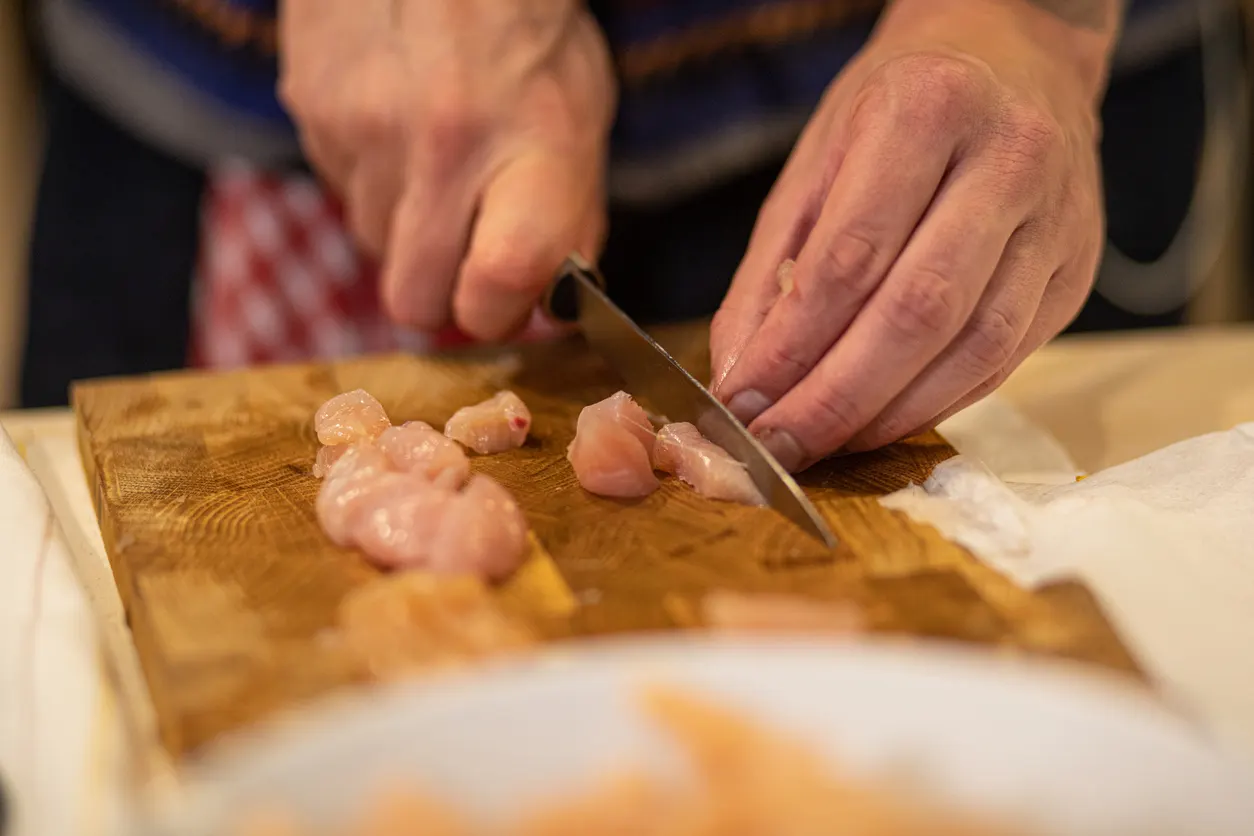Tips

HANDLING POULTRY
Tips & tricks
Handling poultry can be pretty intimidating. Check out these tips and tricks that we provided to feel more confident in your preparations.
Give us a call or contact us today to get started!
Things you may have known or forgotten. Courtesy of (FSIS) USDA Summer Food Handling.
- Firstly, warm temperatures increase the risk for foodborne illness.
- The time and temperature relationship: Perishable foods (e.g. milk, dairy products, eggs, beef, pork, poultry, fish, seafood, other moist high protein foods or dishes containing these ingredients) should be kept cold (at or below 41º F) or hot (at or above 140º F).
- Acceptable methods for thawing: In the refrigerator at 41º F or less. Under cold water, change water every 30 minutes or less.
- Danger Zone: The “danger zone” is the temperature at which most bacteria grow fast (41º F to 140º F). When the outdoor or surrounding temperature is less than 90º F, perishable foods should not be left out for more than two hours. When it is more than 90º F, perishable foods should not be left out for more than one hour.
As part of the cooking process, don’t put cooked items on cutting boards or plates that were used to prepare or carry raw items to your grill. Cover marinated items. Marinate in the refrigerator, not at room temperature. Reserve a portion of the unused marinade for basting cooked foods. Precooking is OK if grilled immediately afterward. Allow charcoal to heat before adding food. It is best to use a meat thermometer to assess doneness. Calibrate thermometer in slushy ice to 32º F. Cook ground meat and poultry to 165º F (internal temperature) steaks, chops, beef to 145-150º F, pork 160º F, poultry to 165º F for safety and 170-180º F for optimum quality.
- Leftovers Avoid preparing excess amounts of food so you don’t have to worry about left overs, but if you do, keep them at 41º F or less. Good rule is, “When in doubt, throw it out.”
- Other tips If you’re using charcoal etc. cooking at high temperatures, and letting the fat drip into the heat source will produce mutagenic and carcinogenic substances such as polycyclic aromatic hydrocarbons. By banking the coals to one side of the grill and placing the food on the other reduces the amount of drippings that fall on the fire. Cook only to the point of doneness, overcooking will increase formation of harmful compounds. Blackened food is not a good choice.
- Lastly, one more tip. Steam on the grill. It’s a very safe method with virtually no mess. Wrap your meat, poultry or fish in foil with compatible veggies and seasonings, the grill and cook until done. If you open the foil a bit near the end, the Smokey flavor penetrates inside the wrap. When you use charcoal, choose the hardwood chips or chunks rather than briquettes, which contain petroleum by-products. All hardwoods burn chemical aftertaste. With gas grills you slower and don’t leave a can add natural wood chips for flavor. So there you have it!
- Meat should be stored at low temperatures to help preserve its quality and prevent the growth of illness causing bacteria. Chilling meat to below 40º F is recommended. Meat can be chilled or frozen. In order to freeze meat, you must drop the temperature below 28º F.
- Refrigerating Meat Refrigeration is a good way to store meat for short periods of time. Refrigerated meat should be stored below 35º F and wrapped to prevent dehydration, odor absorption, and contamination of the meat and other foods in your refrigerator. You may extend the shelf life of meat by removing the retail packaging and rewrapping the meat in foil. In general, you should consume refrigerated meat within four days of purchase. Cured meat products have a longer, more stable life in the refrigerator. When properly wrapped, preferably vacuum packaged, they can be safely stored in the refrigerator for up to 60 days.
- Freezing Meat Freezing is an excellent way to store meat for longer periods of time. It allows the meat to maintain most of its physical properties, taste, texture, smell, and nutritive properties. Small amounts of Nutrients (salts, proteins, peptides, amino acids, and water-soluble vitamins) will be lost as drip when the meat is thawed. Commercial quick-freezing in a –40º F blast freezer is recommended. Quick-freezing combined with slow thawing in the refrigerator will result in the least drip loss and highest eating quality.
Frozen meat will have a different color than fresh meat. You should learn to recognize the “normal” frozen meat color so that you can identify frozen meat, which may have an unusual color and may have spoiled. Your freezer should remain at a constant temperature that is below 0º(-10ºF is better). If you must remove your meat for short periods of time, it should be maintained at a temperature below 28º F.
Type of Meat – Freezer Storage Time
- Beef – 6 months
- Lamb – 6 months
- Variety meats – 3 months
- Veal – 4 months
- Pork (fresh) – 4 months
- Poultry – 4 months
- Ground beef – 6 months
- Ground lamb – 6 months
- Seasoned sausage – 2 months
- Fish – 6 months
Poultry Chicken & Turkey
- Whole – 189º
- Poultry breasts, roast – 170º
- Poultry thighs, wings – 189º
- Duck & Goose – 180º
- Stuffing (cooked alone in bird) – 165º
Ham & Pork
- Fresh (raw) – 160º
- Pre-cooked (to reheat) – 140º
- Leftovers & casseroles – 165º
Duck Cooking Instructions (5lb Duck)
Cook at 425 degrees for 30 minutes. Drop the temperature to 325 degrees for one hour. Duck should be placed on a rack in a roasting pan and left uncovered for the entire cooking time. You may add any desired liquid to the bottom if the pan. Suggested liquids: orange juice, wine or water
Goose Cooking Instructions (10 – 12lb Goose)
Cook goose at 350 degrees for two and a half hours. Goose should be place on a rack in a covered roasting pan. You may add any desired liquid to the bottom of the pan. Suggested liquids: Red wine, fruit juices, or water
Chicken Cooking Instructions (3.5 – 4 lb Chicken)
Cook chicken at 350 degrees for 1 hour and 15 minutes in a covered roasting pan with a small amount of liquid at the bottom of the pan. Suggested liquids: White wine, water or fruit juices
Smoked Turkey Cooking Instructions
Cook smoked turkey at 325 degrees for two hours. Smoked turkey should be placed in a covered roasting pan with two to three cups of liquid at the bottom of the pan. Suggested liquids: Fruit juices, water, or wine



